
The History of the Teutonic Order of Saint
Mary's Hospital in Jerusalem - 1190-2023
The Teutonic Order, as a new institution was confirmed by the German Crusader leader, Duke Frederick of Swabia, on
November 19th, in the year 1190 and with the capture of Acre, the founders of the hospital were given a permanent site in
the city. Pope Clement III confirmed this body as the "fratrum Theutonicorum ecclesiae S. Mariae Hiersolymitanae"
by the Bull Quotiens postulatur of February 6, 1191 and, within a few years, the Order had developed as a Religious Military
institution comparable to the Hospitallers and Templars, although initially subordinate to the Master of the Hospital. This
subordination was confirmed in the Bull Dilecti filii of Pope Gregory IX of January 12, 1240 addressed to the "fratres
hospitalis S. Mariae Theutonicorum in Accon". The distinct German character of this new Hospitaller Order and the protection
given to it by the Emperor and German rulers, enabled it to gradually assert a de facto independence from the Order of Saint
John. The first Imperial grant came from Otto IV who gave the Order his protection on May 10, 1213 and this was followed almost
immediately by a further confirmation by Frederick II on September 5, 1214. These Imperial confirmations each treated the
Teutonic knights as independent from the Hospitallers. By the middle of the fourteenth century this independence was acknowledged
by the Holy See.
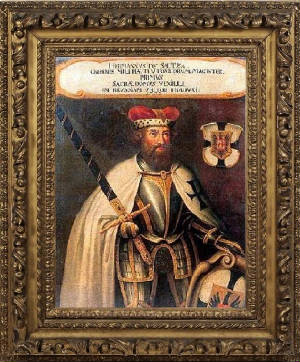
Some forty knights were received into the new
Order at its foundation by the King of Jerusalem and Frederick of Swabia, who selected their first Master in the name of the
Pope and Emperor. The knights of the new confraternity had to be of German birth (although this rule was occasionally relaxed),
a unique requirement among the Crusader Orders founded in the Holy Land. They were drawn predominately from the noble or knightly
class, although this latter obligation was not formally incorporated into the rule until much later. Their blue mantle, charged
with a black cross, was worn over a white tunic, a uniform recognized by the Patriarch of Jerusalem and confirmed by the Pope
in 1211. The waves of German knights and pilgrims who followed the Third Crusade brought considerable wealth to the new German
Hospital as well as recruits. This enabled the knights to acquire the Lordship of Joscelin and, soon thereafter they built
the castle of Montfort (lost in 1271), the rival of the great hospitaller fortress of Krak des Chevaliers. Never as numerous
in the Holy Land as either the Hospitaller or Templar Orders, the Teutonic knights were nonetheless a formidable power.
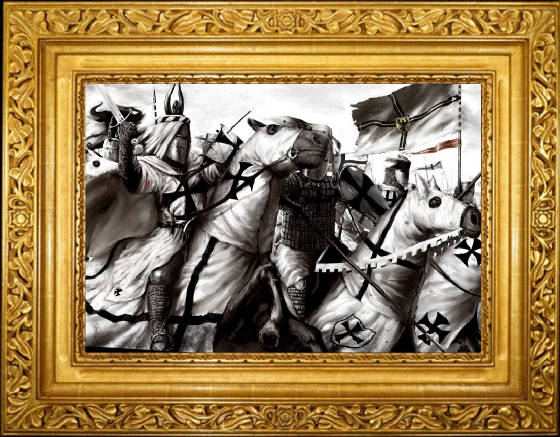
Master Heinrich von Walpot (died 1200), who led the
knights in their first decade came from the Rhineland. He begun by drawing up the Order's statutes, ready by 1199, which were
confirmed by Innocent III in the Bull Sacrosancta romana of February 19, 1199. These divided the knights into two classes,
knights and priests, the former being obliged to take the triple monastic vows of poverty, chastity and obedience as well
as promise to aid the sick and fight the Infidel. Unlike the knights, who from the early thirteenth century had to prove "ancient
nobility", the priests were relieved of this obligation and their function was to celebrate the Mass and other religious
offices, to administer the sacraments to the knights and the sick in their hospitals and follow them as almoners into war.
Priests brothers could not become Masters, Commanders or even Vice-Commanders in either Lithuania or Prussia, but could become
Commanders in Germany. Later these two ranks were augmented by a third class, of serving brothers (Sergeants, or Graumäntler),
who wore a similar mantle but in gray rather than blue and charged with only three branches of the Cross to indicate that
they were not full members of the confraternity.
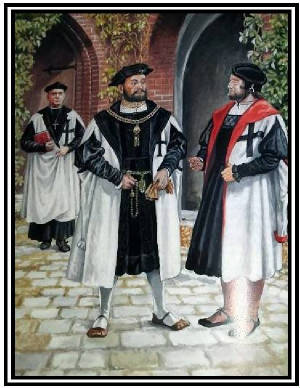
The knights lived communally, sleeping in dormitories
on simple beds, eating together in a refectory, the fare modest and no more than was sufficient. Their clothes and armor were
likewise simple but practical and their daily duties included training for battle, maintaining their equipment and working
with their horses. The dignity of Master - the style of Grand Master came later - was elective for life, as in the Order of
Saint John, and like all the great officers was limited to the professed knights. The Master's deputy, the (Grand) Commander,
to whom the priests were subject, governed the Order in the absence of his superior. The (Grand) Marshal, likewise immediately
subordinate to the Master, was in command of the knights and ordinary troops and was responsible for insuring they were properly
equipped. The (Grand) Hospitaller was in charge of the sick and the poor, the Drapier was responsible for buildings and clothing,
the Treasurer administered the property. Each of these latter offices were generally held for shorter terms, rotating annually.
As the Order expanded across Europe, it became necessary to appoint Provincial Masters for Germany, then Prussia and later
Livonia with an hierarchic structure paralleling the great offices.
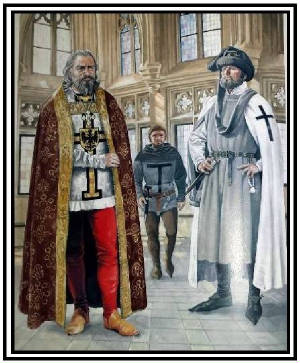
Walpot's successor, Otto von Kerpen, came from
Bremen and the third Master, Herman Bart, from Holstein, illustrating the broad distribution of the early knights. The most
important early Master was the fourth, Herman von Salza (1209-1239), from near Meissen who, through his own efforts as a diplomatist,
considerably enhanced the prestige of the Order. His intercessions in the conflicts between Pope and Emperor earned him the
favor of both, augmenting the knights expanding wealth and possessions. During his Magistery the Order received no less than
thirty-two Papal confirmations or grants of privileges and a further thirteen Imperial confirmations. By the middle of Salza's
Magistery the Orders properties extended from Slovenia (then Styria), through Saxony (Thuringia), Hesse, Franconia, Bavaria
and the Tyrol, with houses in Prague and Vienna. There were also outposts in the outer reaches of the Byzantine Empire, notably
Greece and what is now Romania. At his death the Orders estates extended as far as the Netherlands in the north west of the
Empire, south west to France, Switzerland, further south in Spain and Sicily, and east to Prussia. Salza received a gold cross
from the King of Jerusalem as the mark of his Mastership, following the distinguished conduct of the knights at the siege
of Damietta in 1219. By an Imperial act of January 23, 1214, the Grand Master and his successors were granted membership of
the Imperial Court; as possessors of immediate fiefs they enjoyed a seat in the Imperial Diet with the Princely rank from
1226/27. Immediate Princely rank was subsequently conferred on the Master of Germany and, after the loss of Prussia, to the
Master of Livonia.
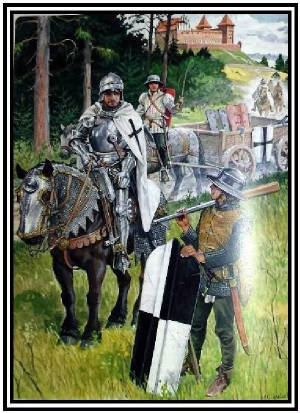
The Order's presence across mediaeval Europe
enabled it to play a significant role in local political events. Despite the limitation of membership to the German nobility,
the spread of German rule into Italy, notably in Sicily under Henry VI and Frederick II Barbarossa, led to the establishment
of the Order's convents in places far distant from Germany. Sicily had been ruled by Saracens until the arrival of the Norman
conquerors under the Hauteville family but the collapse of this dynasty led to their replacement by the German Hohenstaufens.
The first Teutonic hospital, of Saint Thomas, was confirmed by the Emperor Henry VI in 1197 and, in the same year, the Emperor
and Empress granted the knights their request for possession of the Church of Santa Trinità in Palermo. Examination
of grants of Sicilian properties to the three great crusader Orders in the period 1190-1220 indicates that the Teutonic knights
were greater beneficiaries of imperial favor than either the Templars or Hospitallers. Furthermore, when Frederick II attained
his majority he secured them the support of Pope Honorius III, who granted them numerous privileges confirming their equality
with the other two great Crusader bodies. The Teutonic knights had first established themselves in eastern Europe in 1211
after King Andrew of Hungary invited the knights to establish an outpost on the border of Transylvania. The warlike Cumans,
who were also plaguing the Byzantine Empire to the south, were a constant threat and the Hungarians hoped that the knights
would provide a buttress agains their attacks. King Andrew granted them considerable autonomy over the lands they captured
with a mission to Christianize the inhabitants, but their demands for effective independence proved unacceptable and they
were ordered to leave in 1225.
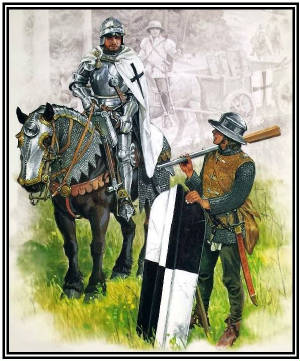
In 1217 Pope Honorius III proclaimed a crusade
against the Prussian pagans. Duke Conrad of Massovia had been invaded by these barbarians and, in 1225, desperate for assistance,
asked the Teutonic knights to come to his aid. He promised the Master possession of Culm and Dobrzin which Salza accepted
with the provision that the knights could retain any Prussian territories that the Order captured. The Emperor's grant of
Princely rank in 1226/27 in the "Golden Bull" of Rimini offered the knights sovereignty of any lands they captured
as immediate fiefs of the Empire. The campaign to drive out the pagan tribes from prussia only lasted fifty years, the consolidation
of their power in north-eastern Europe lasted one hundred and sixty years before the Polish-Lithuanian began to push the knights
backwards. This Crusading enterprise succeeded only at a terrible cost, above all to the native populations but also the lives
of thousands of knights and soldiers. The amalgamation with the knights of the Sword (or knights of Christ as they were sometimes
called) in 1237 proved of considerable value. The Knights of the Sword were a smaller but poweful military brotherhood based
in Livonia. They had originally been subject to the authority of the Archbishop of Riga but, with the capture of Livonia and
Estonia which they ruled as sovereign states, they were effectively independent. The disastrous defeat they suffered at the
Batlle of Sauler on September 22, 1236, when they lost about one third of their knights including their Master, left them
in an uncertain situation. The solution, union with the Teutonic Order, insured their survival and, henceforth, they had the
status of a semi-autonomous province. The new Master of Livonia, a senior Teutonic Commander, now became a provincial Master
in the Teutonic Order and the knights of the combined body adopted the Teutonic insignia.
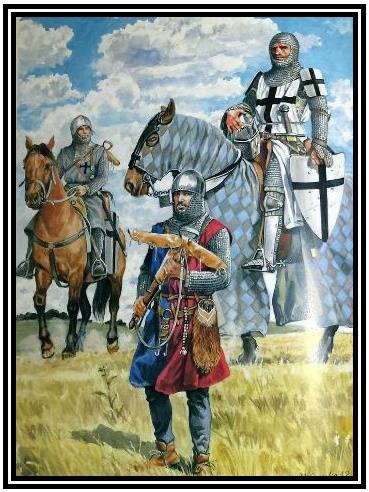
The earliest Livonian knights had come mostly
from south Germany. But, after joining with the Teutonic Order, the Livonian knights increasingly came from areas in which
the Teutonic knights had a substantial presence, principally Westphalia. Virtually no knights were recruited from the local
populations and most of the knights serving in the East spent only a few years there before returning to the Order's houses
in Germany, Prussia or, until the loss of Acre, Palestine. It was not until the middle of the fourteenth century that it became
customary to appoint the Master of Livonia for life as the Order's rule was more settled and service there less burdensome. Salza died during these campaigns and was buried at Barletta,
in Apulia; his shortlived successor, Conrad Landgraf von Thuringen, had commanded the knights in Prussia and died three months
after sustaining terrible wounds at the battle of Whalstadt (April 9, 1241) after just one year in office. The fifth Master's
rule was likewise shortlived but, his successor, Heinrich von Hohenlohe (1244-1253), enjoyed a very successful reign, receiving
confirmation in 1245 of possession of Livonia, Courland and Samogitia from the Emperor. Under Hohenlohe's Magistery the knights
granted a series of privileges regulating the government and ownership of property in Prussia. He also established the Order's
house and future headquarters at Mergentheim (Marienthal) in Franconia, a property which he and his brother had given to the
Order in 1219. By letters patent of August 20, 1250, Saint Louis IX of France granted four gold fleurs de lys to be worn one
at each extremity of the Magistral Cross.
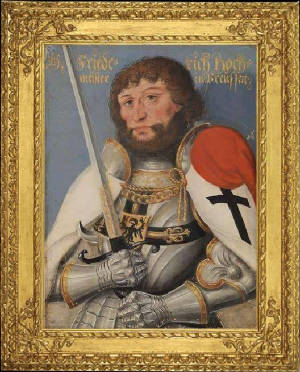
Under the eighth Master, Popon von Osterna
(1253-1262), the Order further established its rule in Prussia, forcing the submission of the ruler of Sambia. The process
of transferring peasant populations from Germany to Prussia now accelerated, while the Order established a feudal structure
of smaller estates owing fealty to the knights. Under his successor, Annon von Sangershausen (1262-1274), the Order's privileges
were confirmed by the Emperor Rudolf (of Habsburg) while the knights were authorized by the Pope to retain their hereditary
estates after profession. This was an important privilege and insured the recruitment of landed knights who could not alienate
their estates because of family obligations. They were also permitted to engage directly in trading activities, previously
forbidden by their vows of poverty, by a further privilege of 1263 which insured their monopoly of the valuable Prussian grain
trade. By the death of the tenth Master, Hartman von Heldrungen (in 1283) the Order was securely established in Prussia with
the vast majority of their subjects converted to Christianity. As they advanced eastwards, however, building fortresses to
insure the maintenance of their rule, the need for local manpower became an increasingly onerous burden for the largely agrarian
civilian population who needed all the hands they could find to maintain their farms. Thus the conscription of young men as
construction workers and foot soldiers - who generally incurred the greatest casualties in war - led to frequent rebellions
against the rule of the knights which sometimes erupted into major conflagrations. Those of the knights subjects who were
captured by the Lithuanians could expect permanent enslavement or, if time was short and circumstances prevented them being
carried off, summary execution. Indeed, the penalties awaiting the prisoners taken by the Lithuanians could be horrific, as
human sacrifice and slow death by torture were not infrequent practices.
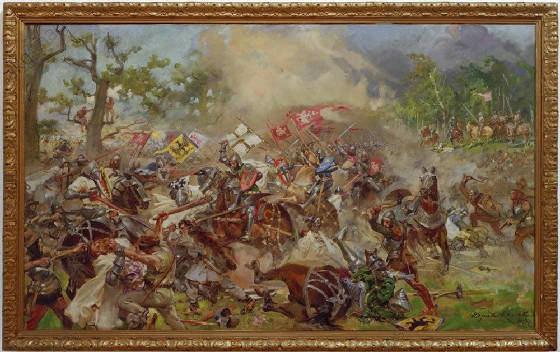
Enslavement of pagan prisoners by the knights was
likewise seen as perfectly acceptable, non-Christians not being considered to have the same rights as Christians. A description
by an Austrian poet, Peter Suchenwirt, quoted by Ekdahl, well illustrates these horrifying events, not so dissimilar, perhaps,
to recent events in Bosnia Herzegovina: "Women and children were taken captive; What a jolly medley could be seen: Many
a woman could be seen, Two children tied to her body, One behind and one in front; On a horse without spurs Barefoot had they
ridden here; The heathens were made to suffer: Many were captured and in every case, Were their hands tied together They were
led off, all tied up - Just like hunting dogs". One can only wonder at the astonishing use of the word "jolly"!
These slaves were then used to supplement the local labor force but, usefully did not require payment and so were often preferred
to the Prussian natives who needed to be paid or granted land. By enslaving the Lithuanian prisoners as much needed manual
laborers, there ceased to be any incentive to convert them as, once they became Christians, they could no longer be abusesd
in this fashion. Hence, as Dr Ekdahl has suggested, as the local populations converted and, following the Christianization
of Lithuania, prisoners of war could no longer be enslaved, the Order found it harder to conscript soldiers into its armies
without detroying the livelihood of the landed peasantry who, through taxes, provided them with much of their revenues
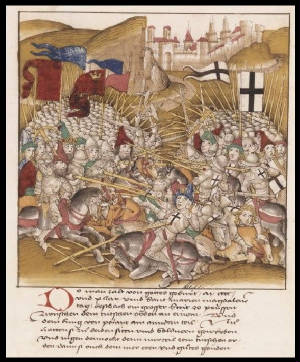
While the Teutonic knights played a major role in
the Christianization of north eastern Europe, they were less effective on its south eastern borders. In the second quarter
of the thirteenth century, Europe was faced with the terrible threat of Mongol invasion. Their spread westwards from their
barren homeland between China and Russia was an appalling experience for those unfortunate enough to find themselves in their
path. They had no regard for the civilian inhabitants who suffered dreadfully, their towns destroyed, livestock carried off,
meanfolk murdered and women either killed or forced into concubinage. In 1240 they attacked and destroyed the magnificent
city of Kiev, capital of the Ukraine, and thence turned to Poland and Hungary. The Teutonic knights seem not to have become
fully engaged in this struggle even when, in 1260, in alliance with the Russian Grand Duke Alexander Nevsky, the Order resolved
to take on the Mongol hordes. Unfortunately, throughout their rule in Eastern Europe the knights were frequently forced to
deal with uprising among their own subjects, particularly in Prussia and each time a crusade was preached against the Mongols
the knights had to turn to defend their own territories from internal rebellion or Lithuanian harassment. With the Crusaders and Christian Kingdom radually on the retreat
in the Holy Land, the knights suffered huge losses at the battle of Sephet in 1265, putting them on the defensive in their
great castle of Montfort. Even after making peace with the Templars and Hospitallers - with whom they had frequently quarreled
during the preceding half century - they were unable to sustain their rule. In 1291, following the loss of Acre, the knights
retreated first to Cyprus and then to Venice, where they had recruited a small group of Italian knights at their commandery
of Santa Trinità which temporarily became the principal house of the Order. Their Master, Conrad von Feuchtwangen,
although before his election Provincial Master in Prussia and Livonia, had fortunately been in Acre when elected and so was
able to demonstrate for his brother knights the military skills learned fighting Prussian barbarians. These efforts having
proved insufficient, he joined his wandering confreres and spent his last years trying to reconcile the differences between
the provincial masters which anticipated the divisions of later years. On his death in 1297 he was succeeded by Godfrey von
Hohenlohe whose Magistery was likewise marred by quarrels among his subordinates, while the struggle against the pagans had
extended to Lithuania.
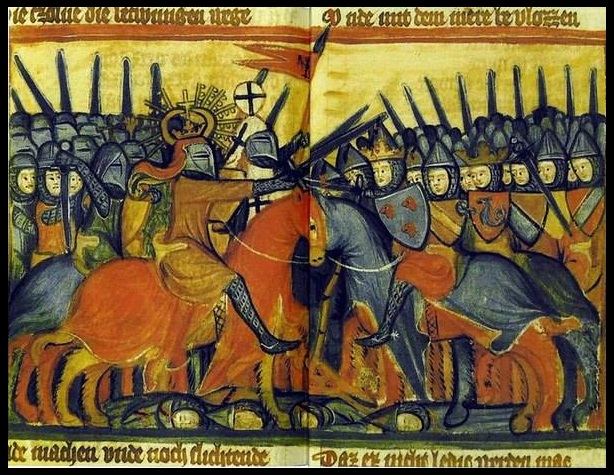
The crusade to convert Eastern Europe was compromised
by some of the local rulers, notably the Kings of Poland, who feared the Order's power and, in 1325, the Poles allied themselves
with the pagan Grand Duke Guedemine of Lithuania. Fortunately, in 1343, Poland and the Order were reconciled and while the
Lithuanians renewed their attacks on the Order with all the forces at their disposal, the knights were ready. Gradually eroding
the areas ruled by the Grand Duke, taking them under their own administration, the Grand Duke Olgerd and seventy thousand
Lithuanians, Samogithians, Russians and Tartars were thoroughly defeated at the Battle of Rudau, in Sambia, on February 17,
1370. The Grand Duke lost more than eleven thousand killed along with his standard, while the Order lost twenty-six commanders,
two hundred knights and several thousand soldiers. In 1386 Olgerd's successor, Jagellon, married Hedwig, heiress of Poland,
took the name Wladislav and converted to Christianity, thus uniting the two Crowns. Poland was now at the apogee of its power,
Christianity was firmly established across Eastern Europe, and the very existence of the Teutonic Knights was now threatened.
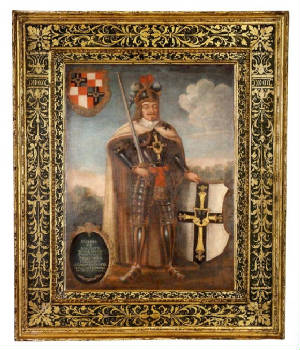
Following the union of Lithuania and Poland, the
Teutonic knights soon forfeited the support of the Church and neighboring Princes. Conflicts with the Archbishop of Riga had
bedeviled relations with the Church over the previous half-century, these divisions were accentuated with the Order's crusading
mission reduced to insuring the conversion of the pagan populations under the rule. The conversion of Lithuania's rulers gained
the latter the support of the Papacy who ordered the knights to reach a settlement. Disputes between the knights and the new
Polish-Lithuanian alliance increased, nonetheless, and the knights even found themselves engaged in the war between two other
Christian states, Denmark and Sweden. A temporary peace signed in the Order's favor in 1404 led to the sale of Dobrzin and
Ziotor to the Polish king but, although the Order's wealth had never been greater, it was brought down by its own success.
The Order now ruled a vast area with two million one hundred and forty thousand inhabitants of Prussia alone but was resented
by much of the native population and feared by its neighbors. As the Polish state became more centralized, so the Crown needed
to enforce its rule along the borders with the Teutonic properties, while requiring easier access to the Baltic coast. As
long as the Order looked to Germany and the Emperor for support, conflict was inevitable.
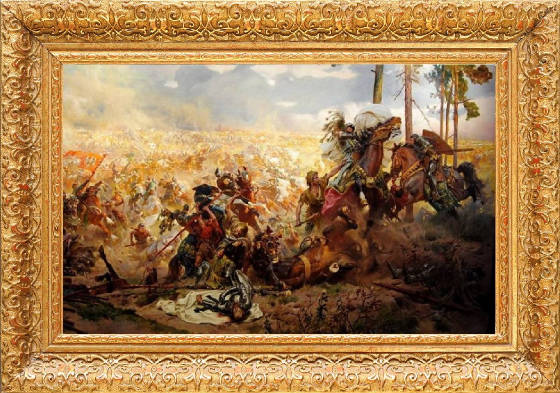
The Lithuanians and Poles were armed and prepared
to renew the struggle. Despite attempted interventions by the Kings of Bohemia and Hungary, Jagellon and Wladislav were able
to amass a vast force of about 160,000 men. These included Russians, Samogitians and Hungarian, Silesian and Bohemian mercenaries
along with the forces of the Duke of Mecklemburg and the Pomeranian Dukes (other than the Duke of Stettin, who sided with
the Order). The knights, on the other hand, with only 83,000 men were outnumbered two to one. Despite this handicap, the outcome
of the engagement at what is known as the battle of Tannenberg on July 15, 1410 was by no means certain. Early in the conflict
the knights made great advances, destroying the right wing of the Lithuanian forces but they were gradually beaten back. When
their courageous Grand Master, Ulrich von Jungingen was killed in the center of the melée, dying from wounds inflicted
in both the front and back of his chest, the fight was lost. In addition to their leader, they lost two hundred knights and
forty thousand soldiers including the Grand Commander, Conrad von Liechtenstein, the Marshal, Friedrich von Wallenrod, and
many commanders and officers, while the Poles lost sixty thousand dead.
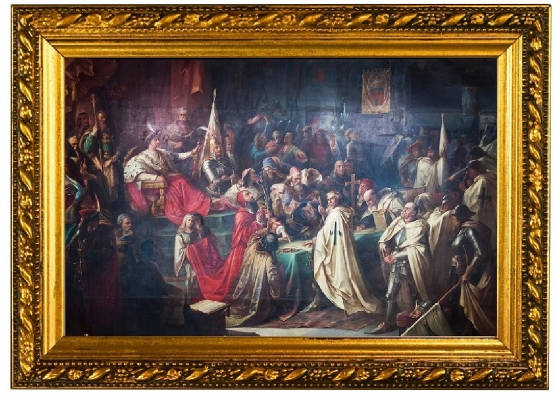
The Order might have been destroyed entirely
had it not been for the Commander of Schwetz, Heinrich (Reuss) von Plauen, who had been charged with the defense of Pomerania
and now moved rapidly to bolster the defenses at Marienburg. He was quickly elected Vice-Grand Master and, thanks to his preparations,
the fortress was saved. Plauen was now elected Grand Master and, at the Isle of Thorn (Torún), concluded a treaty with
the King of Poland on February 1, 1411, ratified by Papal Bull a year later. This returned all the territories captured by
each side to the other, with the provision that Samogitia would be held by the King of Poland and his cousin Vutautas (Witold),
Grand Duke of Lithuania (now a Polish vassal) during their life times when it would be returned to the knights. It was also
required that both sides would endeavor to convert their remaining pagan subjects to Christianity. Unfortunately the Polish king immediately refused to honor his promise to
release his prisoners - whose numbers exceeded those held by the knights - demanding a huge ransom of 50,000 florins. This
presaged a further decline in relations; the Poles were determined to remove the continued threat of the knight's power on
their borders. Numerous negotiations and agreements failed to produce a satisfactory compromise, while many smaller conflicts
gradually diminished the Order's territories. The Order was assisted briefly by a split between members of the Polish royal
house over which of them should rule in Lithuania but this was resolved after four years in 1434. Unfortunately, Wladislav
III who succeeded later that same year acquired the Hungarian throne in 1440, becoming the dominant power in the region. Casimir
IV who had succeded as King in 1444, placed one of his sons on the latter throne while acquiring that of Bohemia for another.
The great problem faced by the Polish Crown, and which ultimately led to the emasculated Monarchy of the eighteenth century,
was how to balance royal authority over the great magnates with the extensive privileges that they had to be promised to insure
their loyalty. This inherent weakness was ably exploited by the knights and delayed their eventual defeat.
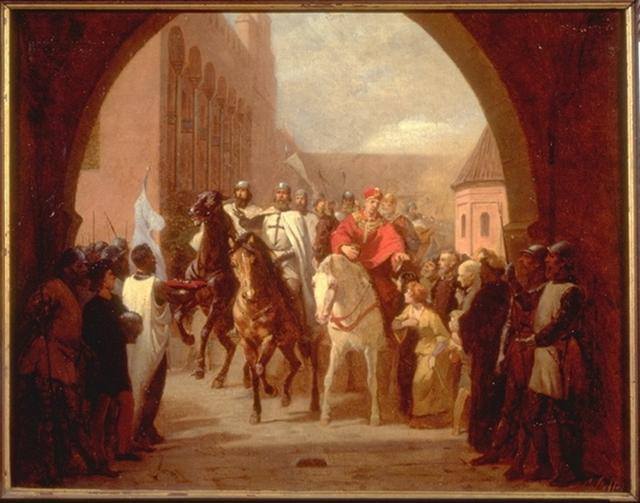
Meanwhile the Prussians themselves rebelled against
the authority of the Order and in 1454 war broke out once again, a conflict that the knights could not win without the support
of their own subjects. Finally, by the treaty of Thorn (Torún) of October 19, 1466 between the Order and Poland the
knights agreed to surrender Culm, their first Prussian possession, along with East Prussia, Michalow, Pomerania (including
Danzig) and the Order's headquarters at the fortress of Marienburg. Although they retained some sixty towns and fortresses
the Grand Master had to recognize the Polish King as his feudal overlord and do homage therefore, although the Emperor, nominal
overlord of Prussia and superior of the Grand Master as a Prince of the Empire, was not consulted. In return the Grand Master
was recognized as a Prince and councilor of the Crown of Poland. The Grand Master acknowledged Papal authority in spiritual
matters, but by promising that no part of the treaty could be annulled by the Pope he was in breach of canon law as the Superior
of a Religious Order and therefore subject to the Holy See. The knights power was now fatally compromised. The next four Grand Masters, thirty-first through thirty-fourth
in succession, were unable to prevent further conflicts with Poland although some territories lost earlier were recovered.
In 1498, they chose as thirty-fifth Grand Master Prince Friedrich of Saxony, third son of Albert the Brave, Duke of Saxony
whose older brother George had married a sister of the King of Poland. By selecting a member of one of Germany's greatest
royal houses they hoped to bolster their negotiating position, particularly over the vexed issue of whether they should accept
the status of Polish vassal state. When summoned to make homage, the new Grand Master petitioned the Imperial Diet, which
informed the Polish King that he could not interfere in the Grand Master's free exercise of power in Prussia. Friedrich's
delaying tactics were assisted by their being three Polish kings between his election in 1498 and death in 1510.
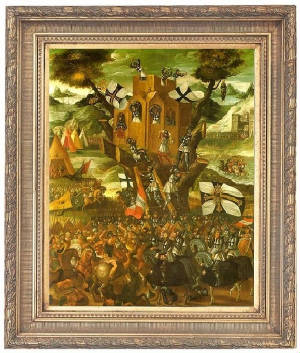
The election of a Prince from a great reigning
family having been such a success, the knights determined on the same course again. This time their choice proved to be a
disastrous mistake. On February 13, 1511, they elected Markgraf Albrecht (von Hohenzollern) of Brandenburg, who accepted the
post, made profession and professed his oath of fealty to the Emperor. Like his predecessor, Albert refused to make homage
to the Polish King Sigismond but was undermined by the Emperor Maximilian, who in a treaty with Sigismond of 1415, required
the Order to revert to the weaker territorial position of 1467. Albert still refused Sigismond's command to attend him, however,
and instead signed an alliance of mutual protection with Czar Vassili of Russia. In return for handing over Neumarck to Brandenburg
for the sum of 40,000 florins, Albert was also able to secure the support of the Elector Joachim. By the treaty of Thorn of
April 7, 1521, he agreed that the question of homage would be submitted to arbitration but the disruption caused by Luther's
defiance was already wreaking havoc with the consciences and loyalties of princes and peoples across Northern Europe and the
promised meeting never took place. Martin Luther's challenge to the established ecclesiastical order led to further losses
of military and political power. Luther wrote to the knights on March 28, 1523, inviting them to break their vows and take
wives. The Bishop of Sambia, who held the administrative posts of Regent and Grand Chancellor of Prussia, was the first to
renounce his vows and, on Christmas Day, 1523, preached a sermon inviting the knights to emulate him. The following Easter
he celebrated the new rite and made a violent attack on the Church in which he had been ordained and consecrated. The Grand
Master at first stood aside but, by July 1524, had decided to abandon his vows, marry and convert Prussia to a secular principality
under his own rule. Following the Treaty of Cracow of 1525, Albert formally converted to Lutheranism and swore fealty to the
King of Poland who invested him as Duke of Prussia with the right of direct or collateral hereditary transmission. Livonia
remained temporarily independent under its Master, Walther von Plettenberg, who was created a Prince of the Empire.
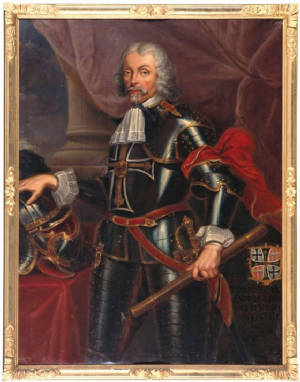
The new Master of Germany now took the title
Master of the Teutonic Order in Germany and Italy. Already a Prince of the Empire as Master of Germany he established the
Grand Magistery at Mergentheim in Wurtemberg, where it remained until the dissolution of the Holy Roman Empire. Weakened by
old age, however, he did not seek confirmation of his titles and resigned, leading to the election of Walther von Cronberg
on December 16, 1526, and the unification of the Headship of the Order with the Magistery of Germany. The latter was now confirmed
by the Emperor, but with the title for him and his successors of "Master of the Teutonic Order in German and in Italy,
pro-Administrators of the Grand Magistery" with the requirement that all the commanders of the Order and the Master of
Livonia give him the respect and obedience due to the Grand Masters of the Order. This title in German was later modified
as "Administratoren des Hochmeisteramptes in Preussen, Meister teutschen Ordens in teutschen und wälschen Landen"
which remained the title of the head of the Order until 1834. At the Diet of Spier of 1529 Cronberg abandoned the seat enjoyed
by the Master of Germany, moving up in precedence to take the seat of Grand Master, after the Archbishop of Salzburg and before
the Bishop of Bamberg. On July 26, 1530, Cronberg was formally invested with the Sovereignty of Prussia by the Emperor in
a solemn ceremony intended to directly challenge Hohenzollern power; unfortunately, it had little actual effect. The Order
still continued to recruit priests and nuns who dedicated themselves to hospitaller and humanitarian services, but the religious
members were effectively separated from the lay and professed knights by the dropping of the requirement that the latter should
live in a convent of the Order. The Order did not lose all its protestant members or possessions however and, where the principality
in which the Order had properties changed confession, the knights generally followed. In Livonia, although Master von Plettenberg
remained loyal to the Catholic Church, he was unable to resist granting toleration to the reformed churches in 1525. Thus
the Order became a triconfessional institution with the Grand Magistery and principal offices held by Catholic nobles. The
Lutheran and Calvinist knights were given equal rights by the Treaty of Westphalia of 1648, with a seat and vote in the Chapter
General. Only the Protestantised Bailiwick of Utrecht declared its total independence in 1637, giving allegiance to the United
Provinces.
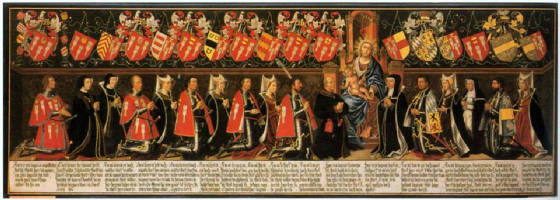
A proposal in 1545 to unite the Teutonic knights
with the knights of Saint John came to nothing. Meanwhile the Order's principal diplomatic efforts were concentrated on recovering
their Prussian territories, a project in which they were to be continually disappointed. Livonia continued under the rule
of the knights but their rule was tenuous, surrounded as they were by Russians and Poles. In 1558 Gothard Kettler was elected
coadjutor Master, succeeding as Master in 1559 on the resignation of Master von Furstenberg. Once again the Order had unwittingly
made a poor choice. While Kettler was a capable soldier, in 1560 he secretly embraced the Lutheran faith. The following year,
after secret negotiations, he was invested by the Polish King in a treaty of November 28, 1561 as Duke of Courland and Semigalla
for himself and his heirs and successors. This state included all the territories formerly controlled by the knights between
the Dwina, the sea, Samogitia and Lithuania and ended the Order's prersence in north eastern Europe. On March 5, 1562, Kettler
sent an Envoy to the King to deliver him the insignia of his dignity of Master of Livonia, including the cross and great seal,
purporting to grant the king the titles and privileges of the Teutonic knights, the keys of Riga and even his knight's mantle,
as symbols of his abandoning the Order.
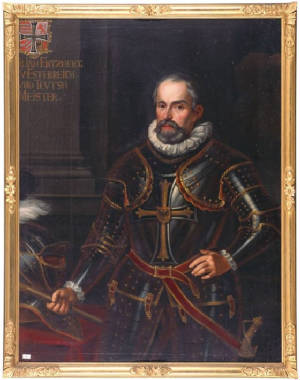
In 1589, the fortieth Grand Master, Heinrich
von Bobenhausen (1572-1595) transmitted the rights of government to his coadjutor, Archduke Maximilian of Austria, without
formally abdicating. This transfer was formally ratified by the latter's brother, the Emperor, on August 18, 1591 and Maximilian
was able to receive oaths of loyalty from the members and subjects of the Order. At the invitation of the Emperor, the knights
then provided 63,000 florins, one hundred and fifty horses and one hundred foot soldiers along with knights from every Bailiwick
of the Order to fight the Turks, then rampaging across south-eastern Europe. This was of course a fraction of what they might
have contributed in the past but the territorial losses of the previous century had seriously impoverished them, substantially
reducing the numbers of professed knights and priests. The Order was now firmly allied with the House of Habsburg and Maximilian
was succeeded in 1619 by the Archduke Carl. Of the remaining years before the fall of the Empire, there were eleven Grand
Masters of whom four were Archdukes, three Princes of the House of Bavaria, and one Prince of Lorraine (brother of the Emperor
Francis I). Thus, while the Order's military power was a mere shadow of its earlier strength, the prominence and standing
of its Grand Masters - and indeed of many of the highest officers - was more elevated. At the same time stricter noble proofs
limited the recruiting of members of the minor nobility.
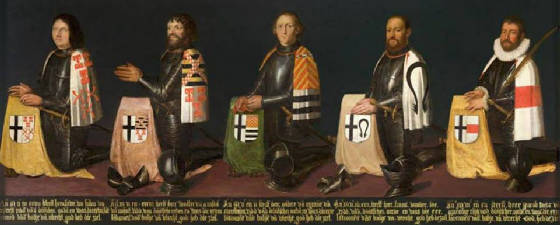
On February 27, 1606 Grand Master Maximilian
gave the Order new statutes which were to govern the Order until the nineteenth century reforms. These comprised two parts.
First the rule, which dealt in nineteen chapters with the religious obligations, communion, the feast days, the habit, the
maintenance of the sick brothers, the conduct of the Order's priests and the regulation of their parishes, and relations between
the members. The second part, in fifteen chapters, was concerned with the ceremonial for arming and receiving knights, noble
proofs, the obligations to fight the Infidel on the Hungarian frontier and elsewhere, the conduct of each member, the administration
and enjoyment of commanderies, the rites due to deceased members including the Grand Master himself, the election of his successor
and the circumstances in which a knight could leave the Order. These reestablished the Order's central mission of fighting
the pagans and, for the Catholic members, restored its spiritual dimension. Unfortunately, by the second quarter of the eighteenth
century, the great powers had abandoned the concept of the Christian Crusade - indeed, knights of the Holy Sepulcher were
excused their promise to fight to free the Holy Places. Stripped of its historic mission and most of its military functions,
the Order henceforth limited itself to providing a regiment for the service of the Archdukes of Austria, Holy Roman Emperors
and a living for the professed knights and priests.
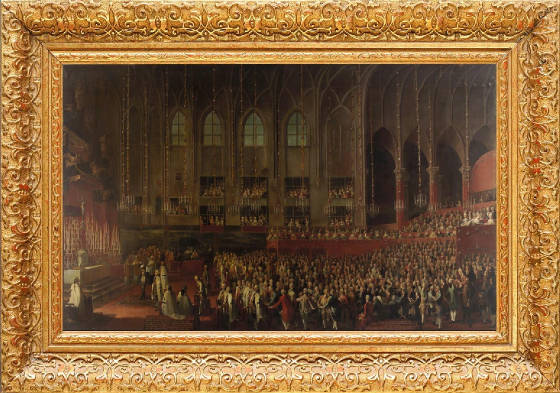
The Napoleonic wars proved disastrous for the
Order, as they did for every traditional Catholic institution. By the Peace of Lunéville of 9 February 1801 and the
Treaty of Amiens of 25 March 1802, its sovereign possessions on the left bank of the Rhine, with annual revenues of 395,604
florins were distributed among the neighboring German sovereigns. In compensation the Order was given the chapters, abbeys
and immediate convents of Voralberg in Austrian Swabia and the immediate convents of Augsburg and Constance. Its Grand Master,
the Archduke Carl-Ludwig had taken office without either making his vows or being enthroned but nonetheless signed away its
properties. The Order was given the ninth vote in the Council of Princes of the Empire, although the proposal to change the
name from Grand Master to Elector was never effected and the dissolution of the Empire soon made this position irrelevant.
On June 30, 1804 Carl-Ludwig resigned the Grand Magistery to his coadjutor, the Archduke Anton, who then made solemn profession.
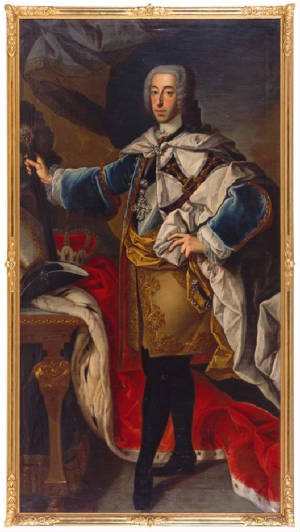
By article XII of the Treaty of Pressburg of
December 26, 1805 between Austria and France all the possessions of the Grand Magistery at Mergentheim and all those given
in exchange earlier were attached to what was to be an hereditary Grand Mastership, invested in the male line of the Imperial
House of Austria. The new Grand Master, the Archduke Anton, was the son of the Emperor Leopold II and brother of Francis I
of Austria, and had already been elected Prince Bishop of Munster and Archbishop of Cologne. On 17 February 1806, the Emperor,
Francis I, acknowledged his brother Anton as Grand Master of the Teutonic Order, confirming the provisions of the Treaty of
Pressburg, until such time as it would become an hereditary dignity. At the same time he also imposed some limitations on
the scope of the Treaty, to the detriment of the Order. The sovereign status recognized in the treaty of Pressburg was now
to be attributed to whichever Prince of the House of Austria would in future hold the title of Grand Master, but this would
be a limited sovereignty, subordinated to the "Headship of the Imperial House of Austria". The existing members
were confirmed in their position, those received as novices were to be permitted to proceed to profession and candidates for
the novitiate could continue their progress, but in a notable modification of the Grand Master's rights, future candidates
for the novitiate could not be received without Imperial assent. No attempt was made to consult the Holy See and this act
was in contravention of canon law. Meanwhile, the formation of the Confederation of the Rhine on July 12, 1806 cost the Order
possession of several more commanderies, granted variously to the Kings of Bavaria and Wurtemberg and the Grand Duke of Baden.
By decree of Napoleon, on April 24, 1809, the Order was suppressed in the territories of the Confederation, those knights
who were not engaged in the armies opposing the French were required to be compensated by their new rulers and Mergentheim
(Marienthal) was handed over to the Crown of Wurtemberg. The only bailiwicks remaining undisturbed were those of Austria,
with three commanderies attributed to the Grand Commander and eight other commanderies and one convent, and the bailiwick
of Adige and the Mountains. The commandery of Frankfurt am Main (Sachsenhausen) was retained, and in Austrian Silesia it preserved
two commanderies and some parishes but lost the commandery of Namslau in Silesian Prussia, confiscated by the Prussian secularization
commission on December 12, 1810. Despite pleas on the Order's behalf for the enactment of the terms of the treaty of Pressburg,
the Congress of Vienna of 1815 refused to return any of the properties it had lost in the preceding twenty years of conflict.
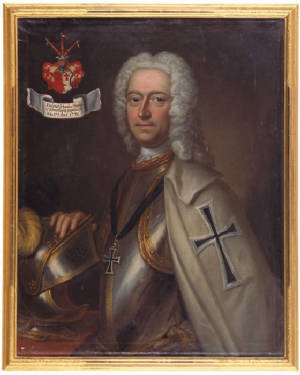
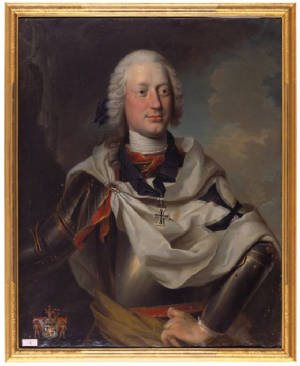
The decision on how to treat the Order was postponed
until February 20, 1826, when the Emperor Francis asked Metternich to determine whether the Teutonic Order should have its
autonomy restored within the Austrian states. There were now only four professed knights in addition to the Grand Master;
the Order urgently needed regeneration or it would disappear. By a decree of March 8, 1834, the Emperor returned to the Teutonic
knights all the rights they had enjoyed by the Treaty of Pressburg, abrogating the limitation on those rights imposed by the
Decree of February 17, 1806. The Order was now declared to be an "Autonomous, Religious and Military Institute"
under the protection of the Emperor, with an Archduke as Hoch- und Deutschmeister and the status of "immediate fief of
the Empire" while the Grand Master, the Archduke Anton, was to be treated as a Reigning Sovereign in all the Austrian
States. His successors were required to request investiture from the "sovereign of Austria" and would be considered
Ecclesiastical Vassal Princes, ranking before "all secular and ecclesiastical princes". The Emperor would become
"suzerain and protector of the Order".
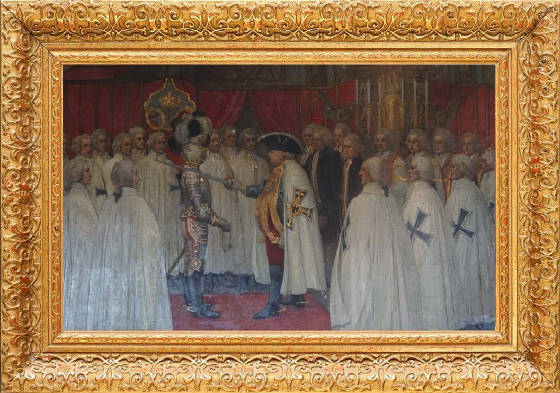
The Order had one class of knight who had to
prove sixteen quarterings of exclusively German or Austrian nobility, subsequently relaxed to four quarterings for two hundred
years, and be practicing Roman Catholics. This class was divided into Grand Commanders (suppressed by a reform of 24 April
1872), Grand Capitularies, Commanders and Knights. The knights were considered to be religious, subject to the discipline
of the Head of the Order while the statutes regulating their conduct were based on those of 1606, restoring the chivalric
character and ancient ceremonies, many of which had become moribund. Following a further reform of 13 July 1865, a division
of Knights of Honour was introduced for which candidates were only required to prove German nobility in the paternal line
and wore a slightly modified cross. The Chapter-General was to include the Grand Commander of the Bailiwick of Austria, the
Grand Commander of Adige and the Mountains, the Grand Commander and Grand Capitular of the former Bailiwick of Franconia and
the Grand Capitular of the former Bailiwick of Westphalia, giving the Grand Master the right to augment the number of Grand
Capitularies at his discretion. A further limitation imposed the obligation to elect as Grand Master (or appoint as coadjutor)
a member of the Imperial House of Austria and, if there were no Archdukes among the members, to elect the Prince most closely
related to the Imperial House. Although the Emperor had failed to defend the Order against Napoleon, the restoration of its
status was unquestionably his achievement. Emperor Francis died on March 3rd 1835 and the Grand Master one month later, on
April 3rd.
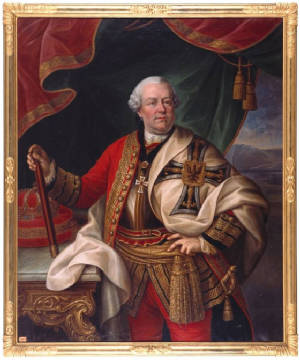
The Order now elected the Archduke Maximilian of
Austria-Este (1782-1863), brother of the Duke of Modena, who had been received as a novice in 1801 and made full profession
in 1804. The new Emperor, Ferdinand I, issued a further decree on July 16, 1839, confirming the privileges granted by his
father and those Rules and Statutes of 1606 which did not conflict with its status as an Austrian fief. A further Imperial
Patent of June 38, 1840, defined the Order as an "Independent Religious Chivalric Institute" and "immediate
Imperial fief" of which the Emperor was suzerain and protector. The Order was given free control of its own estates and
finances, independent of political control and, while the professed knights were considered religious, earlier provisions
permitting them to retain control of their own inheritances were maintained. Their fortunes could be augmented by inheritance
after making profession but gifts by them of more than three hundred florins had to be authorized by the Grand Master. Furthermore,
if a knight died without making a will, his fortune would pass to the Order.
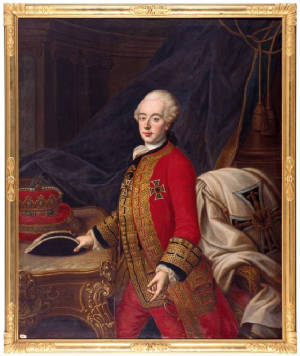
The priests of the Order did not have to make noble
proofs but were required to descend from a gentle family. In 1855, more than two centuries after the disappearance of the
convents of ladies of the Order, the institution of Lady Hospitallers of Saint Mary of Jerusalem or Sisters of the Teutonic
Order, was restored and the Grand Master gave several houses for the sisters at his own personal expense. Certain of the properties
outside Austria had been recovered, notably the chapter house in Frankfurt, and these were now occupied by the religious brethren
and sisters. Stripped of its military function, although the Knights were entitled to wear a military uniform, the Order was
now dedicated to a religious, humanitarian and philanthropic mission in a spirit of "brotherly consciousness" and
provided ambulance and hospital services in the wars of 1850-1 and 1859 (with Italy), 1864 and 1866 (with Prussia) and 1914-18.
The reforms introduced by the Archduke Maximilian served to reinvigorate the spiritual life of the Order, with some fifty-four
priests received during his twenty-eight year Magistery. Many ancient buildings belonging to the Order but long left to decay
were restored while the church of the Order in Vienna was given many valuable relics and religious artifacts. By the time
he died in 1863 Maximilian had given more than 800,000 florins for the support of the sisters, hospitals and schools, and
370,000 for the Teutonic priests.
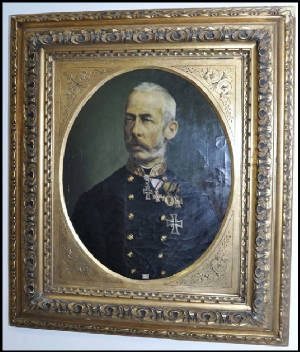
To enable the Order to cope with the demands on its
services, his successor as Hoch und Deutschmeister Archduke Wilhelm (1863-1894, professed 1846), introduced a special category
of Marian knights and dames by a decree of March 26, 1871. These Marian knights and dames were not full members of the Order
but were entitled to wear a variant of the Cross. Initially this category was limited to Catholic members of the nobility
of the Dual Monarchy but by a further reform of 20 November 1880, was extended to include Catholics of any nationality. By
the Bull Pia sodalitia of July 14, 1871, Pope Pius IX confirmed the ancient statutes and regulations, along with the new reforms.
In the Papal Brief of March 16, 1886, Pope Leo XIII approved further reforms to the Statutes drawn up by the Grand Master,
approved by the Chapter-General on May 7, 1886 and sanctioned by the Emperor on May 23 following. These opened up all the
dignities of the Order to those who had professed simple vows, abolishing the category of solemn vows for the future, but
not revoking the solemn vows of those who had already undertaken that obligation. This meant that while knights still had
to make the triple religious vow, because it did not become permanent they could leave the Order and, if they wished, marry
after doing so. This provision did not extend to the priests of the Order whose ordination was perpetual but as a measure
of prudence did include the sisters, since their employment in the outside world as teachers and nurses may have led them
to regret perpetual vows. In 1886 the Order was headed by the Hoch- und Deutschmeister, with a Councilor (Rathsgebietiger),
three Grand Capitularies, eighteen professed knights of whom four were in simple vows, one novice, twenty-one knights of Honor,
more than one thousand three hundred Marianer, seventy-two priests the majority of whom were in solemn vows, and two hundred
and sixteen sisters.
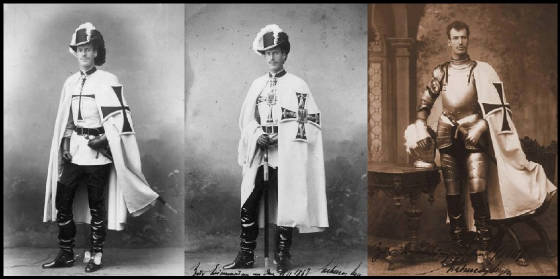
During the last two thirds of the nineteenth
century and the first two decades of the twentieth the Order played an active role in Austrian life, particularly in Austrian
Silesia and the Tyrol. With schools and hospitals under its care serving the local population, and an important hospitaller
role in warfare the Order earned its privileged position within the Dual Monarchy. The First World War, in which the Order
notably distinguished itself, led in the fall of the Monarchy and the abolition of the use of titles of nobility in Austria.
Hostility to the Habsburgs on the part of the new republican régimes in Ausria, Hungary and Czechoslovakia to anything
that recalled Habsburg power was a major obstacle to the Teutonic Order. The threat of bolshevism and rising anti-Catholicsm
coupled with moves to destroy every noble institution and anything that could be accused of being anti-democratic imperiled
the very existence of the Order. The continuation of the Order in its old structure was no longer possible as the properties
of the Order, perceived as dynastic estates of the Imperial House, were threatened with confiscation by vengeful republican
successor states, keen to strike down every remaining association with the Habsburg dynasty.
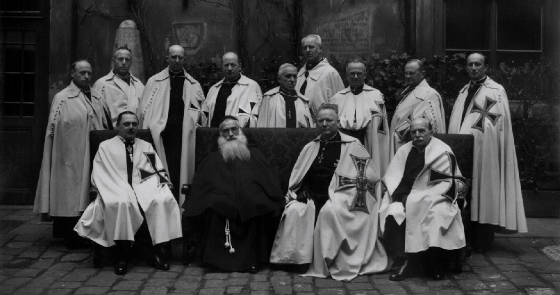
The Order was independent under Canon law as
an autonomous religious institution and could not be regarded as part of the Habsburg patrimony. Nonetheless, the last Habsburg
Grand Master the Archduke Eugene who become Hochmiester of the Teutonic Order in 1894, (who died in 1954), was now forced
into exile along with all the members of the Habsburg dynasty, and volunteered his resignation to the Pope PiusXI in 1923
when certain allegations were made that the property of the order belonged to the Imperial House of Hapsburg. Before this
became final, he convoked a Chapter-General in Vienna to select a new chief and at his suggestion Monsignor Norbert Klein,
a priest of the Order and former Bishop of Brünn (Brno) was elected coadjutor. The Austria government and representatives
of the Order were now able to enter into negotiations and, fortunately, the view that it was above all a religious institution
prevailed, even though some elements in the Church were still hostile. The Holy See now charged Fr Hilarion Felder to examine
the complaints against the Order from within the Church. The argument that as the Order had originally been sbject to the
Hospitallers its properties should be restored to the Order of Malta was rejected and the investigation found in favor of
the Teutonic Order, requiring that it should draw up a new Rule. Now constituted as the Fratres domus hospitalis sanctae Mariae
Teutonicorum in Jerusalem it received Papal sanction of the new Rule on November 27, 1929. The new Rule reconstituted it as
a purely religious Order of priests and nuns headed by the Hoch und Deutschmeisteren, always a priest, who enjoy the style
and precedence of an Abbot with the right to the pileolus violaceus (the violet skull cap).
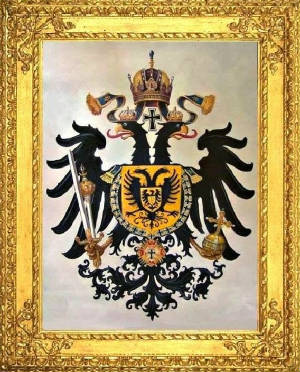
The Teutonic Order of Saint Marys Hospital in Jerusalem
- Deutscher Orden - German Order was formally revived back into a Chivalric Order of Knighthood, thus making a separate Chivalric
Arm of the Teutonic Order from the present Clerical Papal Arm of the Order in Rome, By His Imperial and Royal Highness Prince
Karl Friedrich of Germany, on Christmas Day in the year of Our Lord Two Thousand and One by Imperial Decree. His Imperial
Highness, assumed the Grand Mastership of the Teutonic Order - German Order - Deutscher Orden on the 1st day of Janaury, 2002,
thus becoming the 60th Chivalric Hoch-und-Deutschmeister of the Teutonic Order of Saint Marys Hospital in Jerusalem - German
Order - Deutscher Orden. The administrative seat for the Chivalric Arm of the
Teutonic Order moved back to Mergentheim Castle at Bad Mergentheim in Franconia, Germany
in 2002 under the instruction and decree of His Imperial and
Royal Highness Prince Karl Friedrich of Germany.
